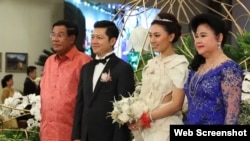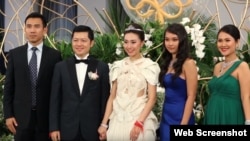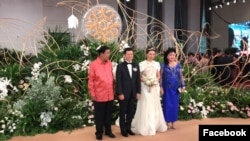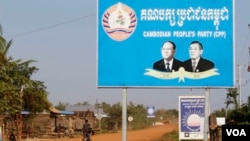When two scions of the ruling Cambodian People's Party (CPP) elite wed in June, they posted a series of videos on YouTube and Facebook celebrating their union — and their wealth.
In “The Love and Honor of Sokan and Leakhena,” Sok Sokan, the son of the late Council of Ministers President Sok An, straps on his Patek Philippe watch before driving his Range Rover to the mansion of Sam Ang Leakhena, whose parents own Vattanac Capital.
The camera cuts away, then lingers over the couple’s diplomas, photographs of the two with their famous relatives, and pauses to allow an appreciation of Vattanac’s balance sheet.
The video oeuvre of Sok Sokan and Sam Ang Leakhena is the digital adaptation of an ancient wedding ritual, hai comnuon, in which the groom’s family marches to the bride’s house bearing the most expensive gifts they can afford.
Rich, well-connected
The videos showcasing the wealth, property and good fortune are igniting a fresh debate over the lifestyles of the rich and well-connected in a country where the per capita annual income hovers around $1,100.
Many of the wedding videos have been widely shared on social media. Mocked by some Cambodians, they are praised by others who said they admired the wealth on display and wished they could afford the same.
“I know it’s my big day and all, but I think you need to see my business, my house and my political party,” Cambodian blogger Catherine Harry wrote beneath the video of Sok Sokan and Sam Ang Leakhena.
Facebook user Lin Na, 32, said she admired the celebration and speculated that it was the couple’s good karma accumulated over the course of many previous lives that enabled them to stage such a spectacle.
Which might be part of the point of the weddings.
Sebastian Strangio, author of the book "Hun Sen’s Cambodia", said that the concept of bun, or merit, is an important aspect of Cambodian political culture and elaborate wedding videos serve a dual purpose — advertising the wealth of the elite families and their underlying merit.
“Ostentatious displays of wealth are a very common way of people transmitting to others that they have reserves of merit built up from good deeds in past lives,” Strangio said. “I think these sorts of videos telegraph the fact that the individuals within them are meritorious and they deserve the wealth that they have, and because they are wealthy they have legitimacy.”
Fighting back against criticism
When Sar Kheng, the interior minister, was criticized because his son’s nuptials blocked traffic in central Phnom Penh, his Cabinet wrote to The Cambodia Daily, arguing that large weddings were the natural order of Cambodian society. Those who disagreed, the letter said, “want Cambodia to become the next Syria.”
But this strategy of portraying the elite’s power and affluence as an outgrowth of the natural order may have diminishing returns.
Discontent over the country’s vast disparities in wealth and the limited career and educational opportunities available to the poor has been rising recently. Many analysts point to this as a key factor in the growing popularity of the opposition Cambodia National Rescue Party over the past half-decade.
“It will become an issue if a dawning class consciousness begins to produce a backlash against these ostentatious displays of wealth,” Strangio said.
Sophal Ear, an associate professor of diplomacy and world affairs at Occidental College in Los Angeles, agreed that videos showing extravagances of the political elite could backfire.
“Of course, if you have the money to burn and want to create a fantasy video that rubs people’s noses in it, you can,” he said. “But things can backfire when the perception is that there is something unjust that resulted in this outcome. Flaunting ill-gotten gains can rub people the wrong way.”
The risk is particularly high because the CPP’s own brand is explicitly incorporated into many wedding videos, which often show couples being blessed by Prime Minister Hun Sen, a onetime Khmer Rouge commander, or other high-ranking government officials.
“The Love and Honor of Sokan and Leakhena” shows Sok Sokan campaigning for the CPP in the June commune elections, while Sam Ang Leakhena works in her Vattanac Tower before the two come together in an embrace. Party logos appear frequently suggesting that this is a union of two of the CPP’s leading families.
“The point of all this is to solidify the relationships of the elites through interlocking marriages that will ensure the survival of the families of the elites,” Ear said.
Families with connections
Yim Beauramey, the granddaughter of two deputy prime ministers, and Meas Sophearith, the son of General Meas Sophea, commander of the Royal Cambodia Army, produced a video depicting themselves as lovers in four historical eras: Longvek, Angkor, the Sangkum regime of Norodom Sihanouk, and what they dubbed the “Decho Era,” a reference to Hun Sen.
And when the children of tycoons Ly Yong Phat and Kok An tied the knot, one of the proud fathers broadcast the entire extravagant ceremony on his eponymous television channel, the Phat News Network.
Phay Siphan, a spokesman for the Council of Ministers, rejected any suggestion that the marriages of CPP elites were due to political or economic considerations.
For those Cambodians who feel alienated by the extravagant celebrations, he advanced a trickle-down theory of wedding economics.
“In a free economy, when one party spends, another will gain,” he said. “In contrast, if rich people do not spend, it will affect the economy.”
But Phay Siphan countered his own theory by saying the CPP weddings were based on love, pure and simple.
“Love has no limits,” he said. “In Cambodian folktales, some people even fell in love with snakes and giants; therefore, love has no limits.”










